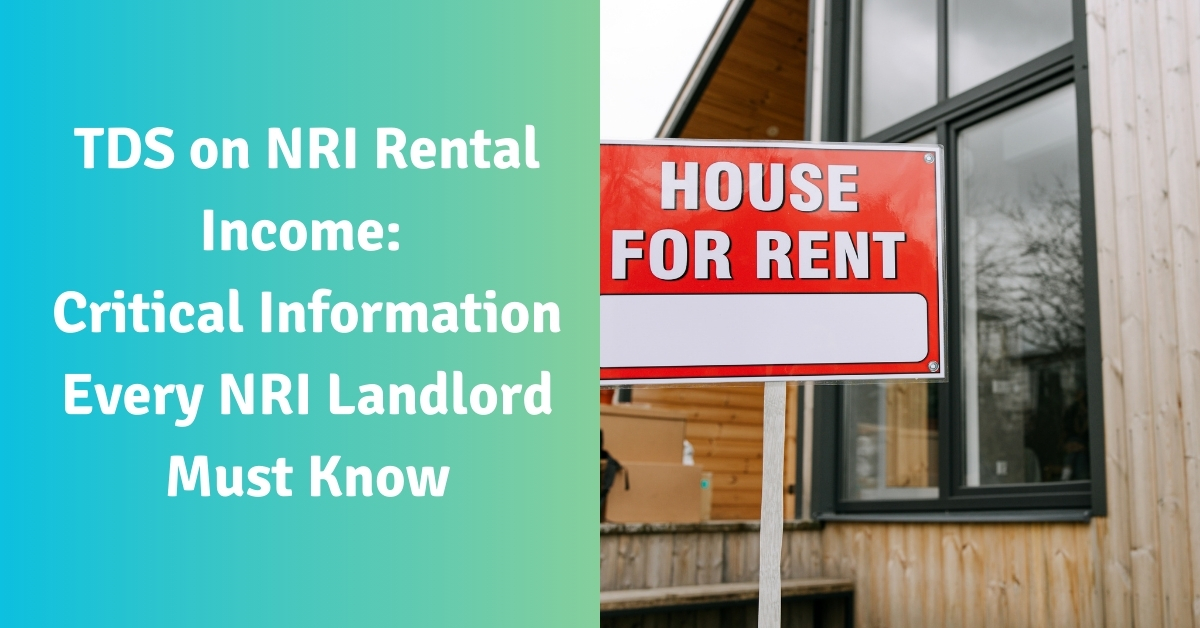TDS on NRI Rental Income: Critical Information Every NRI Landlord Must Know

Renting out property in India is a common practice for Non-Resident Indians (NRIs) looking to generate income. However, the tax implications for NRI landlords differ significantly from those for resident Indians. Many NRIs and their tenants are unaware of these differences, particularly when it comes to Tax Deducted at Source (TDS) on rental income. Failure to comply with these tax regulations can result in severe penalties for both parties. This blog will dive deep into the tax responsibilities of NRIs renting out properties in India, with a focus on the critical aspect of TDS.
A Real-World Cautionary Tale
Imagine this situation: An NRI owns an apartment in Mumbai and leases it for ₹90,000 per month to a salaried professional. Despite providing their Indian address and PAN in the rental agreement, they do not disclose their NRI status. This seemingly minor omission sets off a series of issues down the line, particularly for the tenant, who unknowingly deducts only 5% TDS on the rent, as required for resident landlords. However, for NRIs, the TDS rate is significantly higher at 30%, plus applicable surcharges and cess.
The Consequences of Miscommunication
- The tenant, unaware of the NRI status, fails to deduct the correct TDS.
- The NRI landlord, assuming the tenant knows about their NRI status, ends up in a tax compliance issue.
- Ultimately, the tax authorities catch this mistake, resulting in financial penalties for both the tenant and the landlord.
Why TDS on NRI Rental Income Is Different
The Difference in TDS Rates
- For resident Indians: The tenant is required to deduct only 5% of the rent as TDS.
- For NRIs: The TDS rate skyrockets to 30%, along with applicable surcharges and cess, as per Section 195 of the Income Tax Act.
A Newer Requirement
The mandate to deduct TDS on rent paid to NRIs was introduced in Budget 2017. Before this, tenants were not required to withhold tax at the higher NRI rates, which made this a relatively new and lesser-known tax compliance obligation.
The Consequences of Non-Compliance
For Tenants
Tenants often bear the brunt of non-compliance, especially if they are unaware of the landlord’s NRI status. If the tenant deducts the wrong TDS rate, they could be classified as an “assessee-in-default.” This means:
- The tenant could be held liable for interest on the TDS shortfall.
- They might also face penalties for incorrect TDS deduction, which can be as high as 1.5% of the unpaid tax for each month of default.
For NRI Landlords
NRI landlords, too, cannot escape the repercussions of non-compliance. They must:
- Declare the full rental income, regardless of the TDS deducted by the tenant.
- Pay the difference in TDS if the tenant has deducted at the lower resident rate (5%) instead of the required 30%.
- In cases where the NRI landlord does not pay advance tax on rental income, they will face interest charges under Sections 234B and 234C for failing to pay tax on time.
Moreover, tax authorities in India tend to scrutinize NRI cases closely, making it essential for both parties to stay compliant.
Best Practices for NRI Landlords
1. Transparent Communication
The first step to avoid tax complications is clear communication with tenants. NRI landlords should:
- Clearly disclose their NRI status to tenants before finalizing the rental agreement.
- Ensure this disclosure is documented in the lease agreement.
- Provide the tenant with all necessary tax-related information, such as PAN and bank details, so they can correctly deduct TDS.
2. Ensure Proper Documentation
NRI landlords should maintain accurate documentation for tax purposes. This includes:
- Updating lease agreements with the correct NRI status.
- Keeping detailed records of rental income, TDS deductions, and tax payments.
- Ensuring KYC documentation is up to date, as NRIs often need to update details in their accounts due to changes in their residency status.
3. Regular Monitoring
It’s critical to keep a close eye on TDS deductions. NRI landlords should:
- Verify that tenants are deducting the correct TDS rate (30% plus surcharges).
- Keep track of TDS deductions and ensure the amounts are deposited with the Indian tax authorities.
Preventive Measures
For New Rentals
- Include explicit NRI status declaration in lease agreements
- Provide written instructions about TDS requirements
- Consider including TDS compliance in rental terms
For Existing Rentals
- Send formal communication about NRI status
- Update existing agreements if necessary
- Ensure proper TDS implementation going forward
Conclusion
The key to avoiding tax complications as an NRI landlord is proactive disclosure and compliance. By clearly communicating your NRI status, ensuring that your tenant deducts the correct TDS, and keeping meticulous records, you can avoid potential penalties and legal complications. It’s also advisable to seek professional tax guidance to ensure that you remain compliant with Indian tax laws.
Remember, a little caution today can save you from hefty penalties and stress in the future.
FAQs
- Q: What is the current TDS rate for rental income received by NRIs?
A: NRI rental income is subject to 30% TDS plus applicable surcharge and cess under Section 195 of the Income Tax Act. - Q: When was the mandatory TDS on NRI rental income introduced?
A: This requirement was introduced in Budget 2017. Prior to this, tenants renting from NRI landlords weren’t required to deduct TDS. - Q: Who is responsible for TDS compliance – the tenant or the NRI landlord?
A: The tenant is responsible for deducting and depositing the correct TDS amount. However, the NRI landlord is responsible for declaring the full rental income and paying any tax shortfall. - Q: What happens if the tenant deducts TDS at 5% instead of 30%?
A: The tenant could be considered an assessee-in-default and face penalties. The NRI landlord would need to pay the differential tax amount plus applicable interest. - Q: How should an NRI landlord disclose their NRI status to tenants?
A: It should be explicitly mentioned in the lease agreement and supported by formal written communication to the tenant. - Q: Can past incorrect TDS deductions be corrected?
A: Yes, but it may involve paying the differential amount with interest and possibly penalties. It’s advisable to consult a tax professional for specific cases. - Q: Are there any exemptions to this TDS requirement?
A: No, TDS deduction at 30% is mandatory for all rental payments made to NRI landlords. - Q: What documentation should NRI landlords maintain?
A: Keep copies of lease agreements, NRI status disclosure, TDS certificates, rental receipts, and all communication regarding tax compliance. - Q: How can an NRI landlord verify if correct TDS is being deducted?
A: Check Form 26AS through the income tax portal, which shows all TDS deductions made against their PAN. - Q: What should an NRI do if they discover their tenant has been deducting incorrect TDS?
A: Immediately notify the tenant in writing, rectify the issue going forward, and consult a tax professional about addressing past shortfalls.




